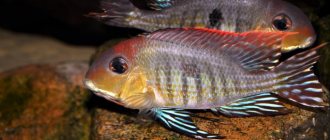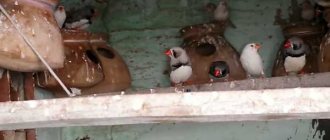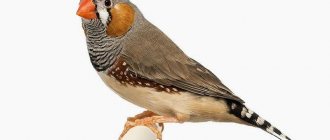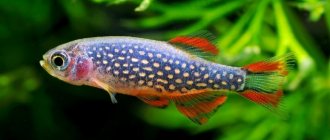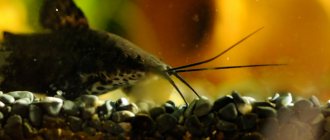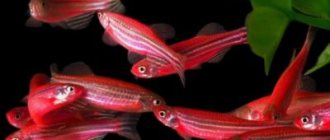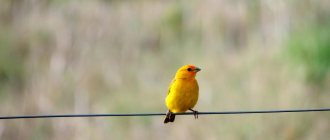Keeping canaries at home
Where does the canary live in the house? Of course, she should have her own house - a cozy cage that has everything for a bird’s comfortable life. Cages made of wood, metal, and three-walled plexiglass are suitable for canaries.
Dark canary
Regardless of the material from which it will be made, it is important to pay attention to the size.
The minimum cage size for one canary is 36x16x24 cm. As a rule, singing males are kept alone.
The minimum cage size for a pair of canaries is 50x25x30 cm.
Important! The distance between the rods should be no more than 1 cm, maximum 1.2 cm, otherwise the bird can easily stick its head between them and may get stuck and die.
Those who want to keep several pairs of canaries in one cage often look at large cages for rodents, which are perfectly sized, but due to the huge distance between the bars, such small birds cannot be housed in them. For several pairs, you need to choose a large cage that is designed specifically for birds.
Only rectangular or square cages are suitable for birds. Round ones look impressive, but you can’t put canaries or any other birds in them; they feel very uncomfortable in cages of this shape.
There should be two of them. One should open outward or rise upward, sliding along the rods. There must be a second door designed to hang the bathing suit.
There must be a retractable tray; this makes cleaning the cage easier; you won’t have to disturb the birds every time by unfastening the bottom completely. This will only need to be done during general cleaning.
Black Canary
Types of cells depending on the material
These are the most suitable and environmentally friendly cages. They can be completely wooden, that is, even the rods are made of wood. But more often the frame and pallet are made of wood, and metal rods are inserted. Cages are made from ash, oak, and beech. These are the most expensive, but most comfortable cages for birds.
- Metal with plastic pallets
These are the most common and cheapest cages and can be found in any pet store. They come with chrome-plated, galvanized or painted rods. Since canaries do not chew anything, you can choose a cage with any bars.
Reference. The bird will be better visible through galvanized or chrome-plated rods. Against the background of rods painted with blue, green, yellow paint, the bird may “get lost”; it is better to choose white ones.
Such cages can be seen in pet stores, where birds are displayed on display for sale. The three walls of the cage are made of transparent plexiglass, and the front wall and roof are made of metal rods. Thanks to the closed three walls, the birds practically do not scatter debris around the cage, while they have enough air and lighting. There must be a retractable tray for cleaning. You can make such a cage yourself or order it from a craftsman; they are rarely on sale.
Selection of accessories
Many cages, usually metal ones with plastic trays, come with accessories, but not all of them are suitable.
Cage with accessories for canaries
If the kit comes with plastic perches, throw them away immediately. Birds are not allowed to sit on them. Only wooden perches are suitable, which are easy to make yourself. For canaries, the diameter of the perches should be about 1-1.5 cm.
Suitable branches willow, any fruit trees, rowan, ash, maple, oak. There is no need to remove the bark, just cut off the knots, if any, you can polish these places to make the perch smooth.
Reference. Only on wooden perches will the canary naturally wear down its claws. This does not happen on plastic ones; the claws grow too long, you will have to catch the bird and cut them, and calluses may also form on the paws.
There is no need to clutter the cage with perches. For a small one, two will be enough. They must be positioned so that the canary does not hit its tail against the bars when it sits on the perch.
Must be specially designed for birds. They are hung on the outside of the cage, and a small container is pushed inside through the bars, into which water is poured from a large bottle. You cannot simply place a container of water in the cage, as the bird may fall into it and drown. Also, water in an open container will constantly become contaminated and quickly deteriorate, which can lead to poisoning of the canaries.
Important! In autumn and winter, one drinking bowl is enough for 1-2 birds. In summer you need to add a second one, as canaries begin to drink much more than in the cold season. If there are more than two birds in one cage, several drinkers are hung at once.
As a rule, the set includes two feeders. But there should be three or four of them in a cage. If there is only one canary, three feeders are enough: one for grain, the second for soft food, and the third for mineral feeding.
House canary
For a pair of canaries you need four feeders: two for grain, a third for soft food and a fourth for mineral feeding.
If there are more than two canaries in a cage, it is best to place one large grain feeder on the floor. A large plastic food container is suitable for these purposes. Birds will climb into it and eat; thanks to the high sides, the grain will not fly away in all directions. You need to pour mineral fertilizer into a small hanging feeder, and use the second one for soft food.
When choosing, it is important to pay attention to its size so that it fits the special door. The bathing suit is hung on this door from the outside.
Important! The top of the bathing suit and its tray must snap securely. If the connection is not secure, there is a risk that the bottom of the bathing suit will fall off due to the weight of the poured water and the bathing canary. For reliability, it is better to fasten the bottom and top of the swimsuit with small screws.
The bathing suit should be hinged. If you put water in some kind of container at the bottom of the birds, they will swim, but they will splash everything around, and after such a bath there will be dirt in the cage, it will have to be washed immediately.
Canaries are much less interested in them than parrots, but you can still hang bells, a mirror and other bird toys to decorate the cage. Swings are useless for canaries - they won't ride on them. Also, ladders are not hung for canaries.
Selecting a location
The cage should be in a well-lit place close to the window, but in no case should the birds be exposed to direct rays of the sun.
Attention! You cannot place the cage on the windowsill, even if the sun's rays do not fall on the birds, it will still be too hot in the summer and cold in the winter.
It is best to place the cage on a table or nightstand next to a window.
Canaries should never stand in a draft, otherwise they will catch a cold and die. Keep this in mind when ventilating the room. Ideally, you need to choose a place for the cage so that when you open the window for ventilation, the birds do not have to be moved to another place.
The cage should not be placed close to heating appliances or under an air conditioner.
Do not place the cage in a place where someone will constantly walk past it and disturb the birds. Choose a cozy, quiet corner for them.
You should not place the cage in the kitchen; the birds may inhale strong odors during cooking and die.
Orange canary
Cleaning
You need to pour sand heated in a frying pan onto the bottom of the cage. You can pick it up near a river, lake, in a pedestrian park, public garden, but not on the playground, where all the yard cats go to the toilet. Sand should be poured into a clean, dry frying pan and placed on the stove. If the sand was wet, you need to wait until it dries in the pan, and then heat it for another 10 minutes. This way all germs will be killed. Only this kind of sand can be poured onto the bottom of the cage. You can also buy sand for birds at a pet store.
This is the best bedding for canaries. The droppings will immediately mix with the sand, and the birds will not get their tails dirty. In this case, you will have to clean the cage every 3-4 days. You need to pull out the pan, scrape off the old sand with droppings and grain husks with a spatula, wash the pan with soap and pour in new sand.
General cleaning is carried out every 2-3 weeks. At this time, the canaries are released to fly or transferred to a small carrier cage or cardboard box. During general cleaning, wash the tray, perches, all feeders, drinkers, as well as the bars of the cage outside and inside with laundry soap.
Bird care
Caring for a canary is not difficult, you need to feed the bird properly, regularly clean the cage, put on a bathing suit every 3-4 days, trim its claws if necessary, let it fly and love it very much. That's all there is to caring for this cute creature.
To trim nails, you need to purchase special scissors at a pet store. If the perches are wooden, then the claws will wear off, but there are times when you need to carefully catch the canary and shorten them.
Attention! The claws must be trimmed very carefully, only the tip, so as not to touch a blood vessel. It is clearly visible, visible through the light claws.
You should let your canary fly at least once a week. It is necessary to close all the windows and the door to the room, remove or curtain the mirrors, close the windows with curtains so that the bird does not crash into them, take cats and dogs out of the room.
If you devote time to your feathered friend and release it more often, the canary can be tamed. The best way of taming is in a large mosquito net, which is also called a canopy. It is hung over the bed; the ends of the net should not be lowered to the floor, but carefully tucked under the bedspread on all sides. The result will be a closed space, fenced with a net, but spacious enough for such a small bird to fly.
What do they eat?
The main food is a grain mixture of canary seed, rapeseed, yellow and red millet, hemp, poppy, oatmeal, and chumiza.
Chumyza
Once every 5-7 days they give soft food: a boiled chicken egg, grated carrots or an apple.
In the summer they always bring leaves and flowers of dandelion, plantain, shepherd's purse, knotweed, and panicles of wild cereals. In winter, green oats are grown in cups and placed in a cage.
Crested
You have already seen what crested kenars look like in real life. Now let's talk about who is usually classified in this category. This group includes 4 varieties:
- crested cauliflower;
- Lancashire Large canaries can be crested or crestless. If there is a crest, it is distinguished by fairly large dimensions. Therefore, he slightly covers the bird’s eyes. They have a whimsical disposition and require careful care;
- Gloucester. It is considered the smallest, since the body length from head to tail is only eleven centimeters. These birds can have a crest that does not cover the bird’s eyes, or without it;
- baptism
Reproduction of canaries: features and stages
Male and female birds are placed in a nesting cage during the breeding season, which usually begins in the second half of March.
Soon the canary begins to build a nest. In most cases, they will breed in open beaker nests - sometimes even adding nesting material to her dish if she decides it is a good place to raise a family.
Fist sockets are commercially available, but they tend to be quite flimsy and hang up to a certain point. If you can find a good, sturdy cup nest, this will work best for most canaries.
However, some may accept a closed cup socket in the absence of a suitable open cup socket. This is preferable because eggs or chicks are less likely to fall out.
At the beginning of the breeding season, the male begins to care for the hen.
A day after mating, rarely at two-day intervals, the hen lays four to five blue-green, brown speckled eggs. After 13-14 days of incubation, when the hen is sitting on the nest, little tiny canaries emerge.
What to feed a canary
The more varied the canaries' diet, the better they feel. The basis, as for all granivorous birds, is a grain mixture. The grain mixture for canaries includes more different components than for finches and parrots.
The canary food mixture consists of:
- 15 percent canary seed,
- 5 percent yellow millet,
- 5 percent red millet,
- 3 percent hemp,
- 20 percent rapeseed,
- 2 percent poppy,
- 10 percent weed seeds,
- 40 percent oatmeal.
This recipe is not a dogma; many amateurs create their own recipes, taking into account many years of experience.
However, for proper nutrition, one mixture is not enough. The menu can be replenished with greens (lettuce, spinach), vegetables (peppers, carrots), apples.
In addition to grain, canaries are given:
- grated carrots,
- boiled chicken egg,
- fresh herbs,
- fruits.
Don’t forget to include health “products” in your diet: coarse sand is needed to improve digestion, chalk is needed to obtain calcium, activated carbon is needed in case of illness. Birds must have mineral supplements in their cages. Place the feed in a separate feeder.
Drinking water is given boiled and at room temperature.
Breeding canaries at home
If you decide to start breeding canaries at home, then for this you need to choose large birds with beautiful plumage and voice. Vocality is passed on to the offspring on the paternal side; this is also important to take into account when selecting a male.
To breed canaries, the cage is equipped with special nests. The selected pair is placed in a separate cage, or 2-3 females are placed in one canary. In this case, it is enough to have a cage of 45 x 90 x 100 cm. In an enclosure with 2 - 3 males, you can put 8-12 females. Of course, during breeding work only pair breeding is used.
The female lays the first egg on days 3–10. An adult female carries from 3 to 6 eggs. The incubation period is 13 - 14 days. The chicks are fed mainly by females, only occasionally by canyons. Therefore, you can leave the males, not remove them, but if you want to remove the male, the female will handle it on her own. From one female they get 2 - 3 broods in a row.
Very important! During the period of laying eggs and until the chicks grow up, under no circumstances should you touch the cage or move it to another place. This can lead to the fact that the mother ceases to perceive the children as her own and stops incubating or feeding.
The female incubates the eggs for two weeks, then the chicks begin to hatch and after 4 hours the mother begins her first feeding. Young animals eat the same thing as adult parents - grain food, but during this period it is better for them to be given homemade soft food, from a mixture of boiled eggs with ground breadcrumbs.
Grown-up chicks begin their first attempts at their singing voice by 40 days of life, and a full voice is formed only by 8-9 months. At the age of one month, the young animals are removed. In this case, boys need to be seated in separate cages, and girls can be left in one. Gender can be determined by chants; for girls they are intermittent, more like chirping, while for boys they are longer and more uninterrupted.
Canaries live on average from 7 to 12 years, but there are cases of longevity - up to 15 years. This largely depends on proper care and a balanced diet - with vitamin feed.
As birds age, their nails become rougher and longer, and their paws begin to peel. I suggest watching a video on how to trim canaries' claws.
Preparing the site
When approaching the question of how to breed canaries, it is important to build a nesting house for the couple. It should be comfortable for living and contain two doors
Through one you need to put all the necessary equipment - a drinking bowl, a feeder. And through the second hang a special base for the future nest. It can be created from wire.
The cage must be installed in a bright part of the room, but try to avoid direct sunlight
It is important that once residents move in, the structure cannot be moved. Therefore, it is necessary to immediately select a location that suits all parameters.
Make sure it won't interfere.
The base for the nest is important. Without it, the birds will not begin to settle down, which means egg laying will also stop.
It can be ordered at a special pet store or online. If desired, it is easy to create the base yourself.
How the domestic canary came to be
More than 400 years have passed since the time when the first representatives of canaries were brought to Europe from the Canary Islands, which attracted millions of bird lovers in different countries of the world.
The wild canary is much more modestly colored than its domestic descendants. Inconspicuous, grayish-brown, with yellow markings on the lower part of the body and forehead, this bird has a pleasant, beautiful song, which over time has undergone significant changes in domestic forms. Nowadays, rare collectors keep wild canaries, which are very capricious and have difficulty getting used to the conditions of captivity.
Types of canaries
House canaries are exceptionally well adapted to a cellular lifestyle. Over several centuries of canary breeding, many breeds have been developed. All bred breeds are divided into three types:
- Singers, who are distinguished by their melody;
- Colored, having different colors from white to bright (variegated and plain);
- Decorative, which are distinguished by non-standard plumage and body outline.
Song canaries, which until recently had the undisputed leadership among caged birds, are divided into:
- German (roller skaters),
- Belgian (Malintsa),
- Spanish (timbrados),
- Russians (Osvyanochny).
All canaries sing, but not all of them can be classified as singers; the beauty of the singing is taken into account here. Those who breed canaries know that birds with green plumage sing best, followed by yellow and white canaries. But red canaries do not have virtuoso passages in singing, the same applies to motley canaries, which have scarlet feathers in their plumage.
Colored canaries are usually larger in size and can be green, yellow, orange, lemon, white, red, gray, or isobella in color. At the very beginning of the breeding path, domesticated canaries were only green. But with the advent of more and more nurseries for their breeding throughout Europe, their mutation occurred and yellow species appeared.
It was a natural mutation associated with climate change. By the way, not only new climatic conditions can affect the change in the color of birds, but also a change in diet. Now we can admire the variety of color plumage - the result of crossing canaries with other passerine species. In the photo you see canaries with beautiful fiery red plumage.
Ornamental canaries are the least common, since breeding them is a difficult task that requires a lot of experience. These birds are strictly assessed for color and conformation. The song has no meaning. There are giant, humpbacked, crested, curly-haired canaries.
However, in recent years, canaries have lost significantly in popularity to parrots. And among amateurs, especially in our country, there are fewer and fewer true professional connoisseurs of kenar songs. The canary population is now replenished mainly through the breeding of colored breeds that have a much simpler and shorter song.
A reasonable question arises: why has the recent leader faded into the background in modern ornamental poultry farming? The answer is simple: the fact is that over the past decades, many species of parrots and weavers have been domesticated, which are of great interest in keeping and breeding. And no matter how much we love our pets, there is another side to the matter - financial. In the absence of demand, there is no point in mass breeding, which sharply reduces the volume of the species' gene pool.
The canary is, first of all, a songbird; it is a pity that our country is gradually losing the glorious traditions of raising high-quality warblers. If the attitude towards song canaries does not change, then in the future colored and ornamental birds that are not distinguished by good singing will be bred.
Colored
Canaries of this species subgroup differ from others in the variety of existing colors. Scientists explain this fact by the fact that the plumage of birds combines two pigments (lipochrome, melanin). Thanks to the first, birds have black, red-brown, yellow feathers, while the second helps to create bright colorful accents and colors. If the owners want to somehow adjust the color, this can be done with the help of nutrition. For example, sunflower or hemp seeds, which are oily by nature, will darken the bird’s fur, but carrots, crushed corn, and sweet bell peppers will add bright colors.
Due to the dominance of one pigment or another, colored canaries are divided into several types. The main ones took their name from the predominance of pigments:
- lipochrome. As a rule, they are painted in one color without any spots or stripes. They can be bright yellow, white, orange, red and even pink;
- melanin. This group, in turn, consists of four color categories: black, brown, agate, and isabella. Melanin is not always distributed evenly. Because of this, spots, stripes, and variegations may appear. Kenars with symmetrical spotting are in great demand. In general, green is considered to be the original color of songbirds. White birds look unusual and fascinating.
The history of the appearance of red canaries is interesting. To achieve this color, breeders were forced to engage in interspecific crossing, combining the usual yellow canary with a red siskin.
Reproduction of canaries: possible problems
No matter how much we try to avoid problems or how well prepared we are, there is always the possibility of unexpected misunderstandings occurring during canary breeding. We will mention the most common problems and try to give short solutions to them.
- At least one of them is not yet ready (wrong season, poor preparation) or age unsuitable for breeding (adolescent or mature).
- Inconsistency in light (mainly during the day), inappropriate temperature or season, lack of space or nest building materials
- External effects that create fear-anxiety.
- These are unisexual birds.
- Diet poor in essential nutrients or obesity problems.
- Hormonal disorders, diseases, sexual atrophy, hereditary diseases
- Infections of the reproductive system in females
- A woman has weakness in egg extrusion - dystocia
- Lack of calcium and a very threatening condition for the life of birds.
- Taking medications that cause metabolic problems, hormones or infertility.
- The male is young
- The female is much larger in size than her match (size incompatibility).
- The presence or absence of a dense layer of feathers in the male genital area (due to a haircut error)
The eggs didn't hatch
- Damage to eggshells from very sharp sharp toenails
- Infectious agents such as some bacteria
- Parental defects in parents or hereditary diseases
- Low humidity
- Negligence in fulfilling parental responsibilities - illness or death of parents.
- Lack of cleanliness in the nest

